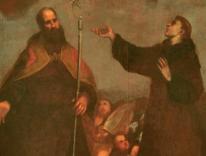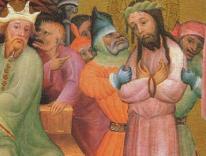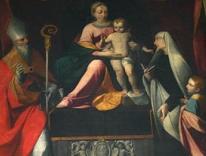Early in 2008 I wrote to the editors of Commonweal to ask if during Lent I might send to the dotCommonweal blog daily excerpts from St. Augustine’s writings. They agreed, and many people were kind enough to thank me for them and interested enough to comment upon the texts. I don’t seem to have repeated this exercise in 2009 and 2010, but each of the years since 2011 I have returned to it and I intend to offer new excerpts this Lent, too.
Last year the editors asked that the excerpts not be published on dotCommonweal but appear rather on the main website of the magazine, under the title “Lenten Reflections.” I agreed to that and have also agreed to the same arrangement for the coming series, even though last year comments on the excerpts were disappointingly few and far between. It would appear that readers of the homepage are not as inclined to comment as are participants in dotCommonweal. But the editors tell me that the Lenten reflections have attracted a lot of people to the home page, and this is significant for the journal’s bottom line. We agreed, however, that there could be a weekly summary or collection of the excerpts, which I believe will appear on Fridays. In any case, if you are interested, you know where you can find them, and, please, feel free to comment. Otherwise I gain the impression that they’ve fallen, to use Hume’s phrase, “still-born from the press.”
Some people have asked me where I found the excerpts.
For some fifteen or twenty years I have tried to read a sermon, or portion of a sermon, of Augustine every morning for spiritual reading. I had never read most of his sermons before, but now that I have, I have discovered a different Augustine from the one I had known and from the one known to people who are familiar only with his great works, the Confessions, the City of God, and the Trinity.
As I discovered the Augustine reflected in his preaching, I began to take notes of passages that particularly struck me either for personal reasons or because of their significance for my theological work, especially in ecclesiology. (It is an occupational hazard for theologians that almost anything they read, even for spiritual reading, can quickly become grist for the theological mill.) I have several files of such excerpts in my computer, and it was on them that I drew for the first series of Lenten excerpts. They did not follow any particular order, and neither will the ones presented this year. They are passages that interest me for their theological, spiritual, or psychological insights, or for the nice balance Augustine achieved between the objective and subjective dimensions of the Christian life, or for their vivid language, not least of all for the literary conceits that I learned to love when studying John Donne and other metaphysical poets (snap quiz: What are the two ways in which Christ may be compared to a camel?), or for reasons having to do with the unplumbed condition of my psyche, or simply because I was having fun.
Scholars estimate that Augustine preached some 8,000 times over his decades as bishop of Hippo, less than a tenth of which have survived. (That’s why there was such excitement when in 1989 thirty sermons, most of them completely unknown before, were discovered in a medieval manuscript.) Most of the sermons were preached at one or another type of gathering of the Church, mostly in Hippo, the others in Carthage and elsewhere in north Africa; a few of them were dictated by Augustine to complete his commentaries on the Psalms and on St. John’s Gospel. The sermons preached were taken down in shorthand by stenographers in his congregation and later written out in longhand and preserved in Augustine’s library. Augustine hoped to include his sermons and letters in the work of “reconsiderations” that he carried through for most of his published works, but controversy and death prevented him from doing so.
Augustine prepared his sermons but did not preach from a written text, and they have thus the character of extempore preaching, very visible (almost audible) in the faithful transcriptions of the stenographers who recorded the stops and starts of an argument, or a sentence, the joy or impatience Augustine sometimes expressed at the response of the congregation, his effort to make himself clearer when he sensed puzzlement among them, his complaints about his health or the strength of his voice, or about the heat, or the smell, in the basilica, his repetition of biblical verses because he knew that most of his congregation could not afford a Bible or could not read, etc. All that makes it possible to re-imagine the encounters between Augustine the bishop and his people, especially in the lively recent translations of the sermons by Edmund Hill and of the expositions of the Psalms by Maria Boulding.
Some people have suggested that I explain why I have chosen each text and feel it useful or pleasant to share it with others. But I don’t always know why I select particular excerpts, and I have preferred to let Augustine speak for himself and to let readers come to their own insights or conclusions. Some texts will appeal to some people and not others, it may even be that some texts will appall some readers and not others! (The same could be said, of course, of the Bible itself or of many great works of literature.) If they help people toward greater insights into the Christian faith and life, to a fuller appreciation of what we believe about God, Christ, the Church, and our own lives as super-abundantly graced sinners, I will be content.
I want to say a final word about Augustine’s use of Scripture. His sermons reveal an astonishing familiarity with the Bible in both Testaments. He took the Bible to be a single book of many books, and he often said that it had a single message: everywhere it spoke of Christ and the Church (and by the latter he meant the actual Church, that is, congregations of Christian believers in a worldwide communion). Following New Testament authors, he believed Old Testament figures and events to be prefigurations, or types, of what was revealed in the New Testament and of what was unfolding in the life of the Catholic Church. He had little interest in the surface meanings of biblical texts–he once said it was like admiring beautifully sculpted letters on a building and not wanting to know what they spell.
Many people find much of his figurative or allegorical or typological readings indigestible, and I certainly do not recommend most of them as helps toward understanding the literal meaning of biblical texts. But I don’t read Augustine for that purpose (for which I have recent commentaries), but for the way in which he uses the texts as occasions for exploring the height and depth, length and breadth, of the Christian life. Seeking the deeper meaning of the biblical texts, Augustine was guided by the concrete life of the Church. It was not so much his exegesis of the Bible that led Augustine to his understanding of Christianity as his experience of life in the Christian community that led him to his exegesis.
I mentioned above Edmund Hill’s vivid translations of Augustine’s sermons. When Hill got to the sermon Augustine preached on the figure of the mulier fortis, the valiant woman of Proverbs 31, he offered a note about the allegorical interpretation that Augustine gave that I think is of more general application:
Augustine, to the entire satisfaction of his audience, treats the valiant woman throughout as a figure of the Church, and so is involved all the time in an allegorical interpretation of the text. About this I think a word needs to be said. The most important thing is to understand what he was actually about, what he thought he was doing. Now the obvious thing he was doing was preaching, and for Augustine this meant that he was acting, acting a part with his congregation, engaging not only their attention (which as the reader will observe sometimes wandered), but also their participation. And to do this he quite unashamedly used all the powers of his very vivid imagination. As exegesis of the inspired text, I am quite certain he did not take his off-the-cuff allegorical interpretation very seriously. He is engaging in a marvelous game, a very important game certainly, but still a game: to be played with all the skill and panache at one’s command (the skills of poetry and rhetoric above all), but with enjoyment, light-heartedly, in a spirit of experimentation, of trial and error. He certainly offers explanations of words and phrases at times that he could not possibly have sustained if he had had a more accurate text, or if he himself had been more professionally grounded in the science of biblical exegesis. That’s where he did not take himself too seriously, as I read him, and where we do not have to do so either. But all the same, I suggest that readers will be making a big mistake if they refuse, with a kind of intellectual primness, to allow Augustine’s flights of fancy, absurd or extravagant as they may sometimes be, to kindle their own imaginations. Imagination is a faculty very seriously underrated by professional theologians and exegetes. [Sermons, vol. II, 201-202]
I know that Augustine is not everyone’s cup of tea, and some may find that they cannot bear to read or to praise anything from the writings of a man on whom they blame much of what has gone wrong with the Church or with theology in following centuries. Some of them will dismiss him simply as a clever rhetorician (an example of what Alexander Pope said: “Damn with faint praise”). Perhaps they could read the excerpts as a Lenten penitential discipline, but, if not, as occasions to remember why God created the Delete key.
Please email comments to [email protected] and join the conversation on our Facebook page.
Previous Story
Monday Morning Links: Feb. 16
Next Story
Facing Down Death


